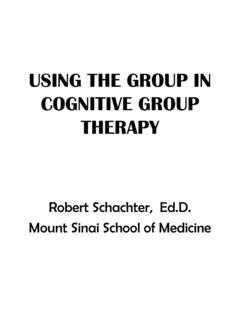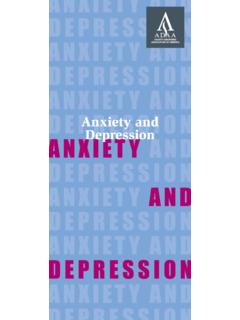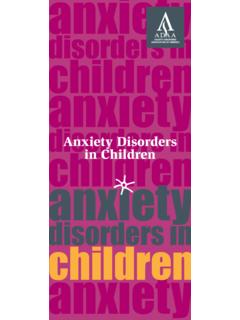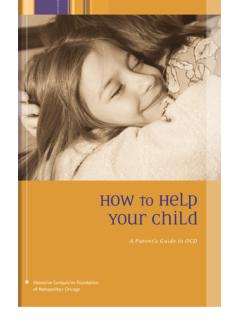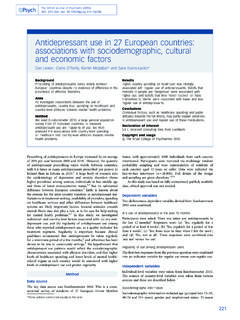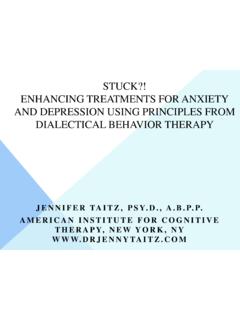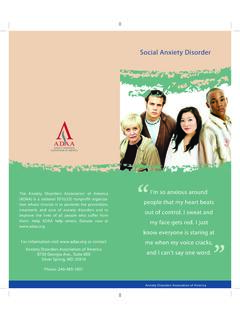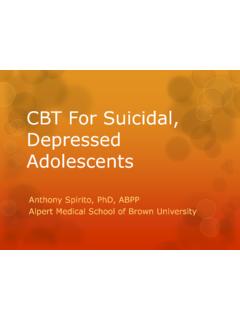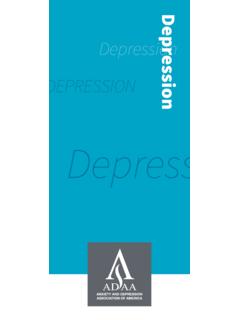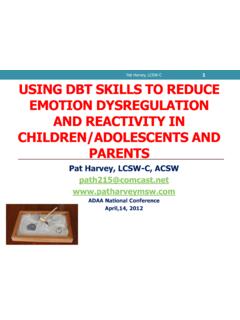Transcription of Distress Tolerance and Skills Building for Adolescent
1 1 Distress Tolerance and Skills Building Group for Adolescents Hotel Dieu Hospital Division of Child & Adolescent Mental Health Services Anita Peter RSW 2 Disclosures No funding or financial supports were or have been received 3 Today s Objectives Summary of the Distress Tolerance Group The Audience will engage in Mindfulness activity and Practice Demonstration and practice of Coping Strategies and a list of Resources will be provided 4 What is The Distress Tolerance and Skills Building Group? Dialectical Behaviour Therapy (DBT) informed Group that has been modified to meet the needs of Adolescents and Teens DBT was developed and created by Marsha Linehan to Work with Adults with Borderline Personality Traits (BPD)
2 5 Dialectical Behaviour Therapy Created to include a Zen Buddhist experience to a Cognitive Behaviour Approach to Treatment People are doing the best that they can in the context of their lives and they need to do better by learning Skills Acceptance and validating one s life situations and using that to create change for oneself are core components of DBT. This allows for supporting and working with Individual with chronic or pervasive emotion dsyregulation 6 Many of the teens referred have a diagnosis of BPD Patterns in their everyday life that are or may be consistent with some BPD traits These may include, maladaptive, unsafe and unhealthy coping, patterns of unstable relationships, impulsive and possibly risky behaviours, and emotion dysregulation.
3 7 Everyone gets Distressed! 8 Who are the Teens that come to Group? Adolescents from 13-18 yrs Adolescents who may engage in self harming behaviours including, cutting, scratching, skin picking and biting and possible overdoses Teens who have difficulty regulating their emotions and exhibit more chronic emotions dysregulation Poor, unsafe and unhealthy coping strategies Problems with their interpersonal relationships, patterns of unstable and chaotic relations All of the teens attending group have a Mental Health Disorder diagnosis.
4 This can include (but are not limited) anxiety disorders, depressive disorder/mood disorders, substance abuse, eating disorders, Attention-deficit/Hyperactivity and conduct disorders. Some of the teens also may have Learning disabilities or low intellectual functioning 9 The 4 main Topics Covered are: Mindfulness Managing Emotions Taking Care of Relationships Distress Tolerance Strategies 10 What are teens doing in group? Mindfulness Practice Cognitive Behaviour Therapy Relaxation Strategies Communication Styles Crisis Management 11 Starting your own group Know your Resources Practice the Skills yourself first Keep the groups Small, 8 teens and under 2 facilitators is ideal Prescreen the Teens for Motivation, Reasons for attending group and compliance to Rules and confidentiality.
5 Keep the group length at 2 hours or under Feed the Teens Provide Practice sheets/Homework each session Include the parents/guardians if possible 12 What to include in a group? Mindfulness Practice each session Mindfulness helps children and adolescents learn to become more self-aware of their thinking, their emotions and any physical changes Improves and increases concentration, memory and focus Helps teens stay with the present moment, rather than worrying about the future or ruminating about the past Mindfulness practice each week allows them to become more attuned to interactions with peers, family.
6 Strangers It helps them to think more carefully about their own emotions and how they could react versus how they would react. Ideas for Mindfulness with Children and Teens mindful eating (raisin, chocolate)* mindful observation and non-judgmental (magazine faces) mindful breathing (body scan) mindful drawing (coke can, Pepsi )* mindful writing (writing with dominant hand and then non-dominant hand) mindful relaxation (Progressive Muscle relaxation) 13 Practice mindful eating 14 15 What to include in group continued Cognitive Behavioral Therapy Useful in helping teens understand that emotions are not separate entities and are very much influenced and linked to our thoughts CBT helps children and teens to learn to identify and work through negative distortions or thinking patterns, in a mindful manner.
7 CBT helps the teens challenge any automatic (hot thoughts) or negative thinking patterns. CBT helps teach the teens that they in fact are accountable for their actions and have the power to change their pattern of thinking CBT helps teens focus on the here and now, opposed to dwelling on past issues to gain insight into their emotional state of mind Use either real life examples if a teen wants support with it, or an example that would fit with a teen s current life situation. Examples: Thought Records/Single Incident Reports 16 What to include in group continued Relaxation Techniques Complete at least one strategy per session and do the technique with them Helps to identify physical changes in their body when there are relaxed vs stressed/not-relaxed Gives them different tools to use in different situations Encourages the use of different tools to manage stress A variety of tools for kids/teens are recommended to keep them engaged.
8 Interested and gives them options for which strategy works better for them Relaxation often doesn t require equipment and teens can be encouraged and convinced to use these techniques virtually anywhere Examples: Guided Imagery, tense and release, 3 senses, Body scan, calm breathing 17 What to include in group continued Naming, Managing and Regulating Emotions Increases children and teens feeling words/vocabulary Helps the children and teen to start connecting the emotion with urges and reactions and possible outcomes Awareness of one s emotions and ability to name them.
9 Allows more opportunity to manage the emotions in a healthy and safe manner Increases the ability to communicates to others what he/she is feeling Teens learn that emotions have a functions/job and are normal experiences and expressions throughout life Increases the chances of a more stable interaction or relations with others Better sense of self (decreases the sense of feeling emptiness, not knowing who she is, Linnahan 1993) Example: Have kids list out all emotions Practice sheet to decipher between emotion, thought and reaction 18 Practice Managing Emotions Progressive Muscle Relaxation 19 What to include in group continued Communication Styles Identifies what form of communication is being used generally (passive, aggressive, passive-aggressive or assertive) Decreased stress.
10 Stress can be better managed with assertive communication (setting up boundaries, limitations) and recognizing need to do vs want to do Teens have an opportunity to express their feelings and thoughts and to also engage in meaningful conversation with others Develop self-control: Learn how others communicate in a constructive and effective manner rather than leading with emotions and having regrets teach the importance of attending behaviours, eye contact, body language, tone of voice and verbal tracking/verbal exchange Example: role play scenarios, How do you communicate Sheet 20 What to include in group continued Distress Tolerance /Coping Skills Basic idea is to learn how to make it through a bad situation without making it worse.
